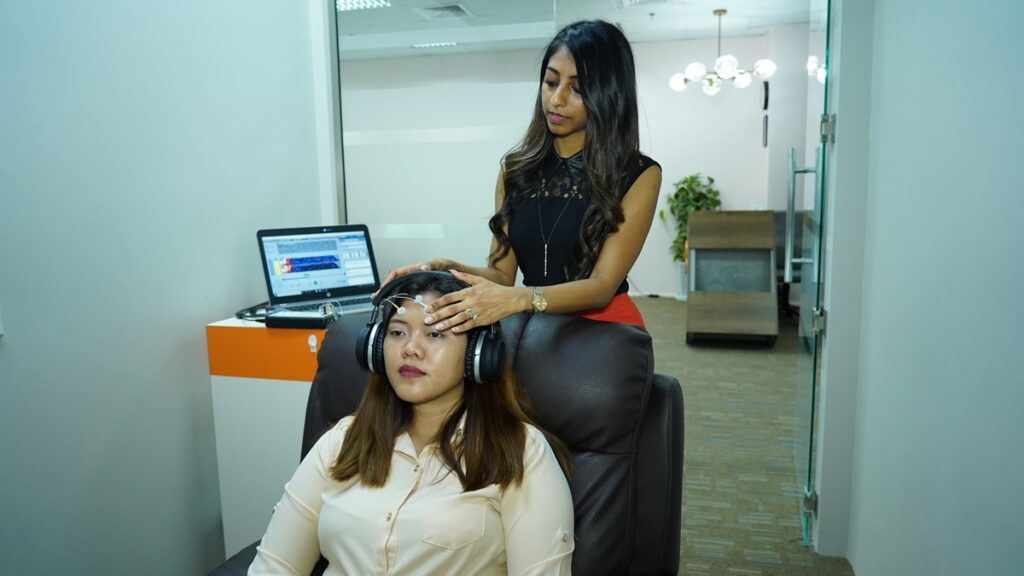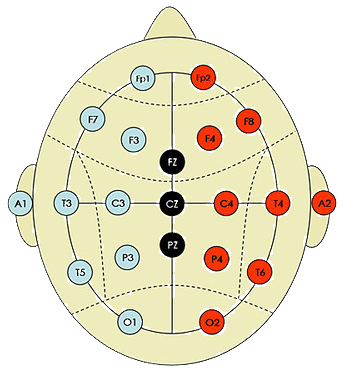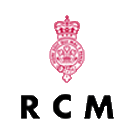Evolve Brain Training: Boost Your Brain | Brain Training Dubai
What is Neurofeedback Therapy: The Complete Guide
Brain training using neurofeedback therapy has paved the way for meaningful, positive changes in the lives of countless individuals. The growing scientific literature on this approach as well as the milestones we see our clients achieve daily is a remarkable confirmation of the real, measurable benefits neurofeedback can deliver.
On this page, we deliver some key information to provide further clarity on what is neurofeedback therapy and the science behind it. We walk you through how each neurofeedback session is conducted in our facility, using a specialist-led, scientifically-proven technology. Moreover, we collated some of the most important studies, research and peer-reviewed articles in recent history that dive deep into the efficacy of neurofeedback to manage a wide range of issues, including ADHD, anxiety, depression, as well as improving brain performance and more.

Topics and Questions
What is Neurofeedback?
What is neurofeedback? How is neurofeedback different from biofeedback? Is neurofeedback a viable alternative to medication? How does neurofeedback help with brain training? If you are looking for answers to these questions, let us help you with this comprehensive guide.
Neurofeedback is biofeedback for the brain. It is a non-invasive technique that helps the brain self-regulate. Improving the brain’s self-regulation helps an individual function better cognitively, emotionally as well as behaviorally.
During a neurofeedback session, we simply measure brain activity using sensors and special software and relay that information back to the brain in real-time via audio and video display. This information about its own activity helps the brain adjust itself for better performance.
Neurofeedback can be a useful tool for anyone looking to maximize their brain’s potential and performance, whether it be athletes wishing to improve their game, adults interested in sharpening their memory, or children dealing with ADHD.
Does Neurofeedback Work?
There is evidence that neurofeedback therapy can be an effective treatment method for patients with certain conditions, such as attention-deficit hyperactivity disorder (ADHD), because it helps relieve a person’s symptoms. It is generally considered safe and comes with minimal risk, and has also been used for treating anxiety, depression, epilepsy, traumatic brain injury and insomnia. Health experts are continuously performing further research and trials on brain training through neurofeedback therapy to learn more ways in which it can effectively improve one’s overall health.
What is Brain Mapping?
Brain mapping is an assessment tool that maps your brain wave activity, and tells you what areas of your brain need attention. This session is perfect for people who suspect they are facing mental health concerns, but are not able to pinpoint them.
Brain mapping is also for people who are curious to know more about how their brains function and what they can improve on. Various issues like focus, anxiety, ADHD, depression, insomnia, fatigue and many more are identified in a brain mapping session. The process also tells you where exactly in the brain these issues arise from, and to what extent they persist.

What Happens in a Brain Mapping Session?
During brain mapping, EEG scanners are used to measure electrical signals in different brain areas. These signals are statistically analyzed to see brainwave patterns. The EEG data is then recorded and processed by a computer software program. This data is compared against a reference database of other people’s EEG. A Quantitative EEG (qEEG) brain map helps us detect the brain area where there is too little or too much activity. It helps to identify amplitude, location and dysregulation. All these are required to understand adequate levels of the client’s mental functioning. If electrical activity is outside the normal parameters, it gives us an indication of possible problems. Brain mapping is a precursor to neurofeedback brain training as it helps in devising an appropriate training plan.
*Note: This video was taken before covid-19. All necessary measures such as sanitization, safe distance and being masked at all times are adhered to.
Know the Different Brainwaves
Neurons in the brain communicate with each other by electrical exchange. This electrical activity is displayed in the form of brainwaves which can be observed using electroencephalogram (EEG).
Delta waves are the slowest brainwave. These are the most relaxing brainwaves. A delta wave appears when you’re asleep. It measures from 0-4 Hz and has the highest amplitude.
Theta waves have greater amplitude. The frequency range is 5-7 Hz. Theta state is seen during light sleep or deep meditation. In this state you may experience vivid visualizations, profound creativity, flow of ideas and exceptional insight.
Alpha waves are produced naturally when you close your eyes and relax. Alpha brain waves are in the frequency range of 8 to 13 Hz. During this state your brain is said to be awake and relaxed.
Beta waves are known as high frequency, low-amplitude waves that are commonly observed while we are awake. The frequency of beta waves is 14-40 Hz. These involve conscious tasks such as critical thinking, writing, reading and socialization seen in day-to-day lives.
Gamma waves are the fastest of brain waves with high frequency. These are observed when processing information from different brain areas simultaneously. Gamma brainwaves pass information rapidly and quietly.
Research indicates brain wave patterns are linked with emotional and neurological conditions. Brain mapping shows brain waves that are associated with over-arousal in certain areas result in fidgeting, impulsivity, hyperactivity and agitation. Under-arousal in certain brain areas is linked to poor concentration, insomnia and daydreaming.

How Does Neurofeedback Work?
In neurofeedback therapy, a computer monitors a person’s brain for brainwave activity then almost immediately provides feedback using audio or visual cues (e.g., lights, sounds, computer games, or even vibrating stuffed toys or cushions). The feedback enables the brain to heal itself through neuroplasticity, or the ability of the neural networks of the brain to change and adapt due to growth and experience in response to extrinsic or intrinsic stimuli by reorganizing its functions and structure. Technicians attach sensors to a person’s scalp to listen to the brainwaves; this information is recorded through an EEG. Specially designed software then relays this brainwave information to the person through a type of stimuli in real time. Through neurofeedback, a person can learn how their brain responds to specific triggers and eventually recognize whenever their brain is in a certain state. Over time, they can recreate a desired state (e.g., being relaxed and happy) or avoid a negative state (e.g., being anxious and agitated).
What Happens During a Neurofeedback Session?
Neurons in our brains talk to each other through synapses which produce the resulting brain waves. At the start of the neurofeedback session, we attach sensors to the scalp which record these brain waves. This process is completely painless and non-invasive.
We do not transmit any signals to the brain; we only listen in on the electrical activity and record the information revealed through EEG. A computer then processes these brain waves and using the software, we show you the ebb and flow of your waves in the form of changes in audio and video output.
The specific frequencies we select and sensor locations on the scalp are uniquely tailored to suit your personal needs. These can vary as you progress through your brain training sessions.
To better understand how neurofeedback works, picture an individual sitting down and focusing on a computer screen. Sensors are attached to the person’s scalp to record their brain activity, and special software relays this brainwave information to them in real time through audio and video.
What to Expect from Neurofeedback Sessions?
A neurofeedback brain training session typically lasts approximately 45 minutes. Training takes 30 minutes, while around 15 minutes are required to collect feedback and prepare the equipment for the session. Normally a minimum of 20 sessions is recommended to experience lasting benefits, although you will start noticing changes within the first few sessions.
The number of sessions required, however, depends upon the intensity and duration of the problem. Being consistent is extremely important to experience the benefits. Every individual is different, and so is their brain. Therefore, neurofeedback therapy for memory improvement, ADHD, anxiety and depression is tailor-made to suit your specific needs.
The Benefits of Neurofeedback Brain Training
Brain training has been proven to be successful in addressing different issues, such as (but not limited to):
Does Neurofeedback Brain Training Work for ADHD?
Neurofeedback makes brain training increasingly feasible. A non-invasive NASA-patented technology, neurofeedback has proven success in addressing different health issues such as focus, depression, anxiety, chronic pain and insomnia. Neurofeedback has also been observed to improve neuroregulation and metabolic function in patients with attention deficit hyperactivity disorder (ADHD).
There is substantial support for using neurofeedback for ADHD as a supplementary treatment from certain medical professionals, specifically some from the ADHD community. One example is Amit Etkin, Ph.D., who is an assistant professor at Stanford University’s Department of Psychiatry and Behavioral Sciences. He says, “The potential for brain training as a new therapeutic tool is phenomenal… By understanding brain circuitry, we can tailor interventions that medication or psychotherapy do not access or improve. The great advantage is that these programs are not invasive, have minimal side effects, and are, for the most part, fun.”
In addition, there are testimonials from parents of children with ADHD who report observing significant control of ADHD symptoms beyond the duration of their children’s neurofeedback therapy sessions. The result? A person’s brain will be able to self-regulate its functions and apply the skills learned to various real-world situations. Studies that have shown longevity of results have reported the same findings.
Neurofeedback therapy could help a person (could be a child or an adult) enhance their memory, improve focus and attention, get better sleep, calm anxiety, elevate athletic performance, or reduce hyperactive or impulsive behavior.
Neurofeedback and ADHD
From low motivation to 120% better focus
Neurofeedback for sharper memory
The result? Happier, energized personal relationships
Are There Any Neurofeedback Therapy Side Effects?
Individuals undergoing neurofeedback therapy rarely experience side effects, but when these do emerge, they are typically transient (meaning, they go away after a short period of time). Examples of such side effects of neurofeedback therapy are dizziness or headaches, fatigue or low energy, anxiety, muscle tension, and cognitive impairment. As with any form of treatment, some clients may experience a period of adjustment with neurofeedback therapy, and that is when these side effects could potentially emerge.
Can You Use Neurofeedback for Memory Improvement?
Recent studies have shown that brain training through neurofeedback therapy can help improve memory function. One study performed at Taiwan’s National Cheng Kung University Department of Psychology revealed that neurofeedback training significantly improved older subjects’ ability to orient memory scores (i.e., a person’s ability to recall details about their environment as well as spatial orientation within a specific time period). This means that attention and working memory performance among normal aging adults were improved. In addition, the study found that younger participants also experienced substantial improvement in their cognitive function thanks to neurofeedback therapy. Another study by a research group led by associate professor Rui Nouchi and professor Ryuta Kawashima of Tohoku University’s Institute of Development, Aging and Cancer in Japan aimed to discover whether brain training using neurofeedback therapy would have a positive impact on a person’s cognitive performance. Their research found that neurofeedback significantly improved working memory, episodic memory, and attention in a group of participants playing a puzzle game. Ultimately, the studies revealed that increased engagement and brain activity during brain training is a major factor in improving cognitive functions.
Achieve peak mental performance
Anxiety replaced by calmer, clearer thinking
Neurofeedback for Peak Performance
As neurofeedback trains your brain to function more efficiently, it can improve mental functioning and emotional stability, leading to better concentration and attention. It reduces human error, enhances creativity and increases immunity to stress. With regular sessions, you can teach yourself better self-control, develop self-awareness and build emotional intelligence, so you can be at your best no matter what circumstances you face.
Neurofeedback is used by amateur and professional athletes, academics and high-performing business individuals to maximize and use the full capacity of his or her brain.
The self-regulation techniques involved in neurofeedback training represent powerful tools for peak performance in many fields. There is global research on this subject highlighting the key performance of ace achievers in fields that require heavy concentration and “being in the zone.” Training their brain via neurofeedback allows one to quiet their mind, and regulate their mental and emotional environment and thereby concentrate more thoroughly. This kind of training provides indispensable tools for both daily life and states highly conducive to peak performance on the field, in school or at work.
Medication and Neurofeedback
Neurofeedback presents a powerful and medicine-free way to fix both common and complex issues, from temporary issues to lifelong conditions. It is a promising alternative treatment for those who do not respond to or experience significant adverse effects from medication. Can neurofeedback be used while a patient is on medication? Yes. Data and our clinical experience confirm that under your physician’s supervision, it is possible to slowly wean off your medications when you start your neurofeedback program. Eventually, you will perform at your best without the aid of medication.
Where Can We Sign Up for Neurofeedback in Dubai?
You, only happier and healthier. It all starts in the brain.
Ask us anything about neurofeedback today. We’re here to help.
Is Neurofeedback Scientifically Proven?
While backed by documented evidence, neurofeedback is still a relatively new methodology. As such, this question continues to be asked and deserves to be answered: “Is there scientific evidence proving that neurofeedback works?”
The following collection of neurofeedback resources provides a solid reference point for anyone interested in further study.
What does science say about neurofeedback? In a nutshell, existing literature indicates sufficient and continuously growing evidence-based information on the use of neurofeedback as a treatment for specific neurological conditions.
Neurofeedback in Scientific Literature
ADHD
- Neurofeedback and Attention-Deficit/Hyperactivity-Disorder (ADHD) in Children: Rating the Evidence and Proposed Guidelines. Applied Psychophysiology and Biofeedback 45, 39–48 (2020).
- Efficacy of Neurofeedback Treatment in ADHD: The Effects on Inattention, Impulsivity and Hyperactivity: A Meta-Analysis. Clinical EEG and Neuroscience, 40(3).
- Evidence-based information on the clinical use of neurofeedback for ADHD. Neurotherapeutics, 9(3), 588-98.
- Current status of neurofeedback for attention-deficit/hyperactivity disorder. Current Psychiatry Rep. 14(5), 536-42.
- Update on attention-deficit/hyperactivity disorder. Current Opinion in Pediatrics, 16(2), 217-226.
- Is neurofeedback an efficacious treatment for ADHD? A randomised controlled clinical trial. Journal of Child Psychology and Psychiatry, 50(7), 780-789.
ANXIETY
- Neurofeedback training improves anxiety trait and depressive symptom in GAD. Brain and Behavior. 11. 10.1002/brb3.2024.
- Using Neurofeedback to Lower Anxiety Symptoms Using Individualized qEEG Protocols: A Pilot Study. NeuroRegulation, 2(3), 137-148.
- Alpha Suppression and Symmetry Training for Generalized Anxiety Symptoms. Journal of Neurotherapy, 13, 146–155.
- Neurofeedback Treatment of Depression and Anxiety. Journal of Adult Development 12(2), 131-137.
- Neurofeedback with anxiety and affective disorders. Child and Adolescent Psychiatric Clinics of North America, 14(1), 105-123.
- Treatment of Chronic Anxiety Disorder with Neurotherapy. Journal of Neurotherapy, 2(2).
- Neurofeedback training improves anxiety trait and depressive symptom in GAD.
- Treatment of Anxiety Disorder with Neurofeedback: Case Study
- Frontal alpha asymmetry neurofeedback for the reduction of negative affect and anxiety.
- Real-Time Functional Connectivity-Informed Neurofeedback of Amygdala-Frontal Pathways Reduces Anxiety.
DEPRESSION
- A Neurofeedback Protocol for Executive Function to Reduce Depression and Rumination: A Controlled Study. Clinical Psychopharmacology and Neuroscience. 2020;18(3):375-385.
- Neurofeedback and networks of depression. Dialogues in Clinical Neuroscience, 16 (1).
- Neurofeedback treatments for depression disorders- review of current advances. Journal of Computer Science and Technology, 7(3), 443-452.
- Neurofeedback as a Treatment for Major Depressive Disorder – A Pilot Study, PLoS One, 9(3).
- Neurofeedback Treatment of Depression with the Roshi. Journal of Neurotherapy, 4(2).
- Clinical Use of an Alpha Asymmetry Neurofeedback Protocol in the Treatment of Mood Disorders. Journal of Neurotherapy, 4(4).
- Review of EEG-based neurofeedback as a therapeutic intervention to treat depression.
PEAK PERFORMANCE
- Enhancing learning in a perceptual-cognitive training paradigm using EEG-neurofeedback. Scientific Reports, 11, 4061 (2021).
- The Relation Between Memory Improvement and QEEG Changes in Three Clinical Groups as a Result of EEG Biofeedback Treatment. Journal of Neurotherapy, 17(2).
- Neurofeedback training for peak performance. Annals of Agricultural and Environmental Medicine, 21(4), 871–875.
- Biofeedback Training for Peak Performance in Sport – Case Study. Macedonian Journal of Medical Sciences, 3(2).
- Peak Performance Training Using Prefrontal EEG Biofeedback. Biofeedback, 40(1), 7–15.
- Neurofeedback for Peak Performance Training. journal of Mental Health Counseling, 3(2), 116-123.
ADDICTION
- Alpha-theta brainwave neurofeedback training: an effective treatment for male and female alcoholics with depressive symptoms. J Clin Psychol, 51(5), 685-693.
- Applicability of brain wave biofeedback to substance use disorder in adolescents. Child and Adolescent Psychiatric Clinics of North America, 14(1), 125-36.
- Neurofeedback Training for Opiate Addiction: Improvement of Mental Health and Craving. Appl Psychophysiol Biofeedback, 38, 133–141.
- Effects of an EEG Biofeedback Protocol on a Mixed Substance Abusing Population. The American Journal of Drug and Alcohol Abuse, 31, 455-469.
- Neurofeedback in Alcohol and Drug Dependency. Introduction to Quantitative EEG and Neurofeedback, 239-267.
NEUROFEEDBACK AND THE HUMAN BRAIN
- Tuning pathological brain oscillations with neurofeedback: a systems neuroscience framework. Frontiers in Human Neuroscience, Article 1008.
- Neurofeedback Training Induces Changes in White and Gray Matter. Clinical EEG and Neuroscience, 265-272.
- Closed-loop brain training: the science of neurofeedback. Nature Reviews Neuroscience, 18, 86-100.
- A Review of qEEG-Guided Neurofeedback. Neuroregulation, 2(3).
- Neurofeedback: A Comprehensive Review on System Design, Methodology and Clinical Applications. Basic and Clinical Neuroscience, 7(2), 143-158.
MIGRAINES
- Comparing the Effectiveness of Neurofeedback and Transcranial Direct Current Stimulation on Sleep Quality of Patients With Migraine. Basic Clinical Neuroscience. 2019;10(6):579-588.
- Clinical and Psychological Confirmation of Stabilizing Effect of Neurofeedback in Migraine | European Psychiatry | Cambridge Core
- QEEG-guided neurofeedback for recurrent migraine headaches. Clinical EEG and Neuroscience. 2011 Jan;42(1):59-61.
The review of existing neurofeedback literature above underscores the efficacy of neurofeedback as a treatment modality for certain psychological conditions. In other words, there is overwhelming evidence from various clinical case studies suggesting that neurofeedback therapy can provide lasting relief from mental health conditions. Fill out the form above for a free, no-strings-attached first consultation.
Where Can We Sign Up for Neurofeedback in Dubai?
Evolve Brain Training is a regional leader in the use of neurofeedback as an effective method for addressing mental health challenges such as depression, anxiety and anger management. Reach out to us to learn if neurofeedback therapy is the right fit for you.

Dr. Upasana Gala is the founder and CEO of Evolve Brain Training, a neurofeedback-centered institute that focuses on using non-invasive brain training techniques to maximize the brain’s true potential.
Frequently Asked Questions About Neurofeedback
Training your brain through neurofeedback therapy is backed up by a rapidly growing body of evidence attesting to its powerful, long-lasting benefits. Neurofeedback addresses a wide range of conditions, including ADHD, anxiety, memory loss and more. To further understand how it can help you or someone you love, here are some neurofeedback FAQs based on the most common queries we receive from our clients.
What’s the difference between neurofeedback and biofeedback?
The difference between neurofeedback and biofeedback is their area of focus. Biofeedback uses sensors and feedback technology to monitor and optimize broad physiological functions of the human body, such as your heart rate, pulse or body temperature. Meanwhile, neurofeedback can be seen as a specialized form of biofeedback tailored to the intricacies of the brain. Neurofeedback specifically focuses on the real-time monitoring and feedback of the brain’s electrical activity to help individuals learn to self-regulate and optimize their brain function.
How much do neurofeedback sessions cost?
You can find our complete price list here – Price List
Will insurance cover neurofeedback?
Here at Evolve Brain Training we do not process insurance claims. We can provide a statement for you to submit to your insurance company.
How many sessions will I need?
Since neurofeedback involves learning and every person is unique, the type, order and pace of change differs from person to person. You will start experiencing benefits within the first few sessions. But for these effects to last, we recommend a full package of 20 sessions. However, some may require more than 20 sessions.
Are the effects of neurofeedback long-lasting?
Neurofeedback is effective in the vast majority of cases and provides measurable results. Almost everyone responds to training, and the results are long-lasting. Our clients report significant improvement and are able to reach their goals 95% of the time — an exceptionally high rate of achievement.
What are the side effects of neurofeedback?
There are no harmful side effects. Neurofeedback is essentially structured exercises for your brain and as with physical exercise sometimes the brain may experience fatigue after the sessions. However, these effects are rare and last only for a few hours.
Does neurofeedback work for depression?
Yes, neurofeedback helps overcome depression. Brain regions and networks involved with mood, motivation, etc. can be strengthened, thus reducing depressive episodes. For more information, click here.
Is neurofeedback safe for children?
Neurofeedback is a suitable training modality for adults as well as children above the age of 6 years.
Can I do neurofeedback if I am undergoing other therapies?
Neurofeedback complements other therapies like counseling very well and can speed up the healing process. If you are taking medications targeting brain function, successful neurofeedback training may require the dosage to be reduced.
What happens during a neurofeedback session?
During a neurofeedback session, you will sit in a comfortable chair and watch your favorite show on Netflix while EEG sensors are attached to your head. Every time your brain does something right, it gets a positive reward in the form of a better picture and sound. For more information, click here.
Can I do neurofeedback at home?
We now provide neurofeedback therapy in the comfort and privacy of your own home or office. For more information on our VIP services, click here.
Ask us your question about neurofeedback today. We’re here to help.
Technology Used By










Book Your Free 15-Minute Consultation
Let us help you make mental health a priority. Get a free, no-strings attached session to get started.
